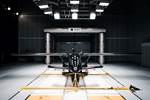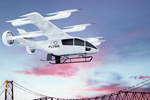Eve Air Mobility completes eVTOL wind tunnel testing
A scale model of the lift + cruise eVTOL aircraft was tested to further refine the understanding of how the components will perform in future flight.
Eve Air Mobility (São José dos Campos, Brazil) recently completed wind tunnel testing of its electric vertical takeoff and landing (eVTOL) vehicle. The testing, which was conducted at a wind tunnel near Lucerne, Switzerland, used a scale model of Eve’s eVTOL which is projected to enter service in 2026.
Wind tunnel testing is an important engineering tool used in the development of an aircraft. The testing enables engineers to monitor the flow of air over and around the vehicle and each of its individual parts. It is also used to measure the aerodynamic forces and moments acting on the vehicle, allowing the team to evaluate the vehicle’s lift, efficiency, flying qualities and performance.
The main objective of the test was to investigate and validate how components including fuselage, rotors, wing, tail and other surfaces would perform in flight. It also provided the company with an understanding of the aerodynamic behavior of complex geometries and provides a higher level of validation of design characteristics. The tests are part of an effort to acquire experimental data to validate production solutions, development tools and models which also includes other test articles such as fixed and moving rigs, flying vehicles and other wind tunnel tests.
“The completion of wind tunnel testing is an important engineering milestone as we continue the development of our eVTOL,” Luiz Valentini, chief technology officer at Eve Air Mobility, says. “The information we obtained during this phase of development has helped us further refine the technical solutions of our eVTOL before committing to production tooling and conforming prototypes. Our goal is to design, produce and certify an aerodynamic and efficient eVTOL that will be used for a variety of urban air mobility [UAM] missions.”
Eve’s engineering team will use the data gathered through wind tunnel testing to continue to develop the eVTOL’s control laws leading to optimal performance and passenger comfort.
Eve’s eVTOL is 100% electric and has a range of 60 miles (100 kilometers) allowing it to complete a variety of UAM missions. Its human-centered design is said to ensure the safety, accessibility and comfort of passengers, the pilot and the community by minimizing noise. The aircraft features a lift plus cruise configuration with dedicated rotors for vertical flight and fixed wings to fly on cruise, with no components required to change position during flight. It will be piloted at launch, but ready for autonomous operations in the future.
Related Content
-
Hexagon Purus opens new U.S. facility to manufacture composite hydrogen tanks
CW attends the opening of Westminster, Maryland, site and shares the company’s history, vision and leading role in H2 storage systems.
-
Lilium launches M&A process, targets eVTOL program continuation
Despite court-approved insolvency filings and beginning first investor briefings, Lilium remains fully focused on re-emerging following restructuring, setting its sights on fresh investment to support the Lilium Jet.
-
Composites end markets: Pressure vessels (2024)
The market for pressure vessels used to store zero-emission fuels is rapidly growing, with ongoing developments and commercialization of Type 3, 4 and 5 tanks.















.jpg;maxWidth=300;quality=90)
